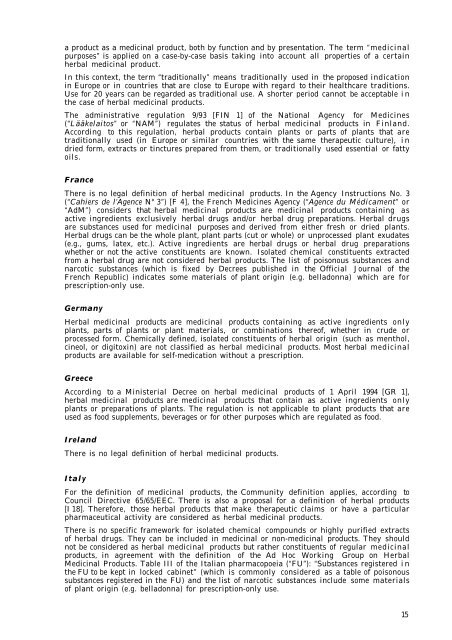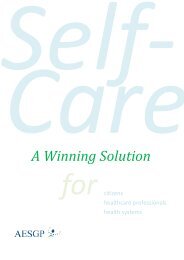Herbal medicinal products in the European Union - AESGP
Herbal medicinal products in the European Union - AESGP
Herbal medicinal products in the European Union - AESGP
Create successful ePaper yourself
Turn your PDF publications into a flip-book with our unique Google optimized e-Paper software.
a product as a <strong>medic<strong>in</strong>al</strong> product, both by function and by presentation. The term “<strong>medic<strong>in</strong>al</strong><br />
purposes” is applied on a case-by-case basis tak<strong>in</strong>g <strong>in</strong>to account all properties of a certa<strong>in</strong><br />
herbal <strong>medic<strong>in</strong>al</strong> product.<br />
In this context, <strong>the</strong> term “traditionally” means traditionally used <strong>in</strong> <strong>the</strong> proposed <strong>in</strong>dication<br />
<strong>in</strong> Europe or <strong>in</strong> countries that are close to Europe with regard to <strong>the</strong>ir healthcare traditions.<br />
Use for 20 years can be regarded as traditional use. A shorter period cannot be acceptable i n<br />
<strong>the</strong> case of herbal <strong>medic<strong>in</strong>al</strong> <strong>products</strong>.<br />
The adm<strong>in</strong>istrative regulation 9/93 [FIN 1] of <strong>the</strong> National Agency for Medic<strong>in</strong>es<br />
(“Lääkelaitos” or “NAM”) regulates <strong>the</strong> status of herbal <strong>medic<strong>in</strong>al</strong> <strong>products</strong> <strong>in</strong> F<strong>in</strong>land.<br />
Accord<strong>in</strong>g to this regulation, herbal <strong>products</strong> conta<strong>in</strong> plants or parts of plants that are<br />
traditionally used (<strong>in</strong> Europe or similar countries with <strong>the</strong> same <strong>the</strong>rapeutic culture), i n<br />
dried form, extracts or t<strong>in</strong>ctures prepared from <strong>the</strong>m, or traditionally used essential or fatty<br />
oils.<br />
France<br />
There is no legal def<strong>in</strong>ition of herbal <strong>medic<strong>in</strong>al</strong> <strong>products</strong>. In <strong>the</strong> Agency Instructions No. 3<br />
(“Cahiers de l’Agence N° 3”) [F 4], <strong>the</strong> French Medic<strong>in</strong>es Agency (“Agence du Médicament” or<br />
“AdM”) considers that herbal <strong>medic<strong>in</strong>al</strong> <strong>products</strong> are <strong>medic<strong>in</strong>al</strong> <strong>products</strong> conta<strong>in</strong><strong>in</strong>g as<br />
active <strong>in</strong>gredients exclusively herbal drugs and/or herbal drug preparations. <strong>Herbal</strong> drugs<br />
are substances used for <strong>medic<strong>in</strong>al</strong> purposes and derived from ei<strong>the</strong>r fresh or dried plants.<br />
<strong>Herbal</strong> drugs can be <strong>the</strong> whole plant, plant parts (cut or whole) or unprocessed plant exudates<br />
(e.g., gums, latex, etc.). Active <strong>in</strong>gredients are herbal drugs or herbal drug preparations<br />
whe<strong>the</strong>r or not <strong>the</strong> active constituents are known. Isolated chemical constituents extracted<br />
from a herbal drug are not considered herbal <strong>products</strong>. The list of poisonous substances and<br />
narcotic substances (which is fixed by Decrees published <strong>in</strong> <strong>the</strong> Official Journal of <strong>the</strong><br />
French Republic) <strong>in</strong>dicates some materials of plant orig<strong>in</strong> (e.g. belladonna) which are for<br />
prescription-only use.<br />
Germany<br />
<strong>Herbal</strong> <strong>medic<strong>in</strong>al</strong> <strong>products</strong> are <strong>medic<strong>in</strong>al</strong> <strong>products</strong> conta<strong>in</strong><strong>in</strong>g as active <strong>in</strong>gredients only<br />
plants, parts of plants or plant materials, or comb<strong>in</strong>ations <strong>the</strong>reof, whe<strong>the</strong>r <strong>in</strong> crude or<br />
processed form. Chemically def<strong>in</strong>ed, isolated constituents of herbal orig<strong>in</strong> (such as menthol,<br />
c<strong>in</strong>eol, or digitox<strong>in</strong>) are not classified as herbal <strong>medic<strong>in</strong>al</strong> <strong>products</strong>. Most herbal <strong>medic<strong>in</strong>al</strong><br />
<strong>products</strong> are available for self-medication without a prescription.<br />
Greece<br />
Accord<strong>in</strong>g to a M<strong>in</strong>isterial Decree on herbal <strong>medic<strong>in</strong>al</strong> <strong>products</strong> of 1 April 1994 [GR 1],<br />
herbal <strong>medic<strong>in</strong>al</strong> <strong>products</strong> are <strong>medic<strong>in</strong>al</strong> <strong>products</strong> that conta<strong>in</strong> as active <strong>in</strong>gredients only<br />
plants or preparations of plants. The regulation is not applicable to plant <strong>products</strong> that are<br />
used as food supplements, beverages or for o<strong>the</strong>r purposes which are regulated as food.<br />
Ireland<br />
There is no legal def<strong>in</strong>ition of herbal <strong>medic<strong>in</strong>al</strong> <strong>products</strong>.<br />
Italy<br />
For <strong>the</strong> def<strong>in</strong>ition of <strong>medic<strong>in</strong>al</strong> <strong>products</strong>, <strong>the</strong> Community def<strong>in</strong>ition applies, accord<strong>in</strong>g to<br />
Council Directive 65/65/EEC. There is also a proposal for a def<strong>in</strong>ition of herbal <strong>products</strong><br />
[I 18]. Therefore, those herbal <strong>products</strong> that make <strong>the</strong>rapeutic claims or have a particular<br />
pharmaceutical activity are considered as herbal <strong>medic<strong>in</strong>al</strong> <strong>products</strong>.<br />
There is no specific framework for isolated chemical compounds or highly purified extracts<br />
of herbal drugs. They can be <strong>in</strong>cluded <strong>in</strong> <strong>medic<strong>in</strong>al</strong> or non-<strong>medic<strong>in</strong>al</strong> <strong>products</strong>. They should<br />
not be considered as herbal <strong>medic<strong>in</strong>al</strong> <strong>products</strong> but ra<strong>the</strong>r constituents of regular <strong>medic<strong>in</strong>al</strong><br />
<strong>products</strong>, <strong>in</strong> agreement with <strong>the</strong> def<strong>in</strong>ition of <strong>the</strong> Ad Hoc Work<strong>in</strong>g Group on <strong>Herbal</strong><br />
Medic<strong>in</strong>al Products. Table III of <strong>the</strong> Italian pharmacopoeia (“FU”): “Substances registered i n<br />
<strong>the</strong> FU to be kept <strong>in</strong> locked cab<strong>in</strong>et” (which is commonly considered as a table of poisonous<br />
substances registered <strong>in</strong> <strong>the</strong> FU) and <strong>the</strong> list of narcotic substances <strong>in</strong>clude some materials<br />
of plant orig<strong>in</strong> (e.g. belladonna) for prescription-only use.<br />
15




